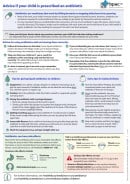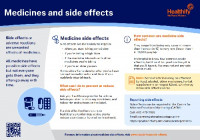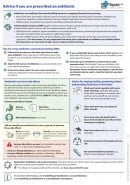Wishing everyone a safe and happy Christmas and New Year – Meri Kirihimete from the Healthify team.
Ceftriaxone
Sounds like 'kef-try-ax-own'
Key points about ceftriaxone
- Ceftriaxone is an antibiotic.
- It's used to prevent or treat different infections caused by bacteria.
- Find out how it's given and possible side effects.

Ceftriaxone is an antibiotic that's given by injection to treat different infections caused by bacteria. It works by killing or stopping the growth of bacteria (bugs) and gets rid of the infection.
Ceftriaxone may also be given around the time of surgical operations to help prevent infection afterwards. Ceftriaxone injection can be given into a vein or muscle.
Like all antibiotics, ceftriaxone isn't effective against infections caused by viruses.
- The dose of ceftriaxone will be different for different people depending on the type of infection, how bad your infection is and the type of bacteria causing the infection.
- Your healthcare provider will also decide how long you need to have ceftriaxone injections for.
- For some infections, a single injection is enough while other infections may need repeated injections for a few days.
- A healthcare provider will usually give you this medicine.
- Ceftriaxone may be injected into your vein, as a slow injection over 2 to 4 minutes or by a continuous infusion over a longer time. Your healthcare provider may call this an 'IV' or 'intravenous infusion' or 'drip'.
- Sometimes, your healthcare provider will give you ceftriaxone by injecting it into a large muscle in your leg or bottom. This is called an intramuscular injection. You may also receive a local anaesthetic at the same time.
- If you're giving ceftriaxone to yourself at home, it may already be prepared by the hospital pharmacy or will be prepared by a district nurse. The injection is either contained in a bag and is designed to drip slowly into your catheter (this is called an infusion) or injected slowly with a syringe. This should be administered exactly as you have been instructed at the hospital or clinic. The infusion should be given over at least 30 minutes. The syringe should be given over 2 to 4 minutes.
Like all medicines, ceftriaxone can cause side effects, although not everyone gets them. If you're concerned about any symptoms you think might be related to your medicine, talk to your healthcare provider. The following information offers some guidance but doesn't include all possible side effects.
Tell your healthcare provider if these side effects bother you.
- Pain, redness, swelling or soreness at the injection site.
- Nausea (feeling sick).
- Diarrhoea (runny poo).
- Headache.
Tell your healthcare provider immediately or phone Healthline free on 0800 611 116 if these occur
- Signs of problems with your liver such as tiredness, yellow skin or eyes, stomach pain.
Phone 111 for an ambulance or go to your nearest accident and emergency (A&E) clinic if these occur
-
Signs of an allergic reaction such as itchy skin, and rash, swollen lips or tongue, problems breathing, like a tight chest or shortness of breath.
Read more about medicines and side effects and reporting a reaction you think might be a side effect.
The following links provide further information on ceftriaxone:
Ceftriaxone(external link) New Zealand Formulary Patient Information
Ceftriaxone-AFT(external link) Consumer Medicine Information, NPS MedicineWise, Australia
Brochures
Advice if you are prescribed an antibiotic(external link) BPAC, NZ, 2024
Advice if your child is prescribed an antibiotic(external link) BPAC, NZ, 2024
Medicines and side effects(external link) Healthify He Puna Waiora, NZ, 2024
5 questions to ask about your medications(external link) Health Quality and Safety Commission, NZ, 2019 English(external link), te reo Māori(external link)
References
- Ceftriaxone(external link) New Zealand Formulary
- Antibiotics – choices for common infections(external link) BPAC, NZ, 2025
Brochures

Advice if your child is prescribed an antibiotic
BPAC, NZ, 2024

Medicines and side effects
Healthify He Puna Waiora, NZ, 2024
Credits: Healthify editorial team. Healthify is brought to you by Health Navigator Charitable Trust.
Reviewed by: Stephanie Yee, Pharmacist, Auckland..
Last reviewed:






